Publisher: Amy Marson Editorial Director: Gailen Runge Acquisitions Editor: Jan Grigsby Editor: Gailen Runge Technical Editors: Gailen Runge, Majorie Russell, Carolyn Aune Copyeditor/Proofreader: Wordfirm Inc. Cover Designer: Kristy Zacharias Book Designer: Kristen Yenche Junior Designer: Kerry Graham Illustrator: Gailen Runge Production Coordinator: Tim Manibusan Photography: Luke Mulks and Diane Pedersen, unless otherwise noted Published by: C&T Publishing, Inc., P.O. Box 1456, Lafayette, CA 94549 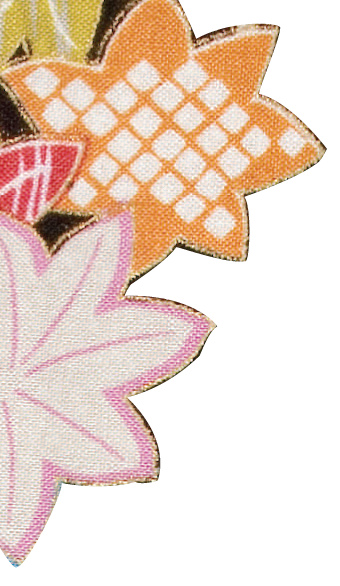
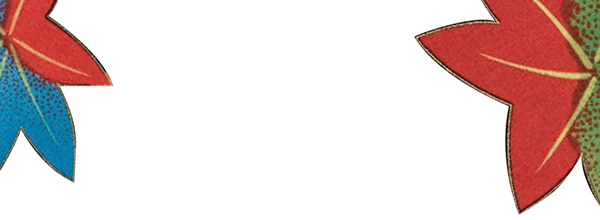 Dedication This book is dedicated to YOU, the beginning quilter. You are about to experience the joy, creativity, and community of the world of quilting. You will be part of and contribute to its rich legacy and continuingtraditions. Enjoy!
Dedication This book is dedicated to YOU, the beginning quilter. You are about to experience the joy, creativity, and community of the world of quilting. You will be part of and contribute to its rich legacy and continuingtraditions. Enjoy! Acknowledgments I would most gratefully like to thank the following people and companies that share my vision, enthusiasm, and love of quilting, both personally and professionally, for their contribution to the industry. C&T Publishing: Amy Marson, Jan Grigsby, Darra Williamson, Gailen Runge, Kerry Graham, Tim Manibusan, and all the staff who continue to create wonderful books. Electric QuiltHusqvarna VikingJo-Ann Fabrics and Crafts StoreQuilters Dream BattingRobison-Anton TextilesSulky of AmericaPeggy Johnson, the Keeper of the Blocks, who helped draft the blocks in the book with The Electric Quilt Company software. Electric QuiltHusqvarna VikingJo-Ann Fabrics and Crafts StoreQuilters Dream BattingRobison-Anton TextilesSulky of AmericaPeggy Johnson, the Keeper of the Blocks, who helped draft the blocks in the book with The Electric Quilt Company software.
Acknowledgments I would most gratefully like to thank the following people and companies that share my vision, enthusiasm, and love of quilting, both personally and professionally, for their contribution to the industry. C&T Publishing: Amy Marson, Jan Grigsby, Darra Williamson, Gailen Runge, Kerry Graham, Tim Manibusan, and all the staff who continue to create wonderful books. Electric QuiltHusqvarna VikingJo-Ann Fabrics and Crafts StoreQuilters Dream BattingRobison-Anton TextilesSulky of AmericaPeggy Johnson, the Keeper of the Blocks, who helped draft the blocks in the book with The Electric Quilt Company software. Electric QuiltHusqvarna VikingJo-Ann Fabrics and Crafts StoreQuilters Dream BattingRobison-Anton TextilesSulky of AmericaPeggy Johnson, the Keeper of the Blocks, who helped draft the blocks in the book with The Electric Quilt Company software.
And thank you to my friends Vicki DeGraaf, Peggy Johnson, Susie Kincy, and John James, for helping with piecing and bindings! Finally, thank you to Michael, Adrienne, and Alexandermy family. 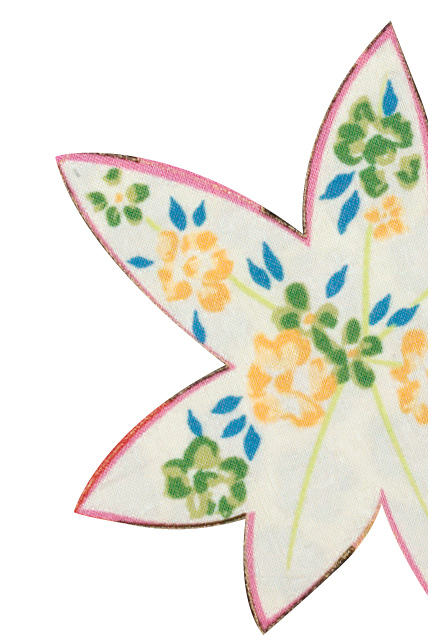 Introduction You are about to set off on an exciting journey of color, fabric, design, and stitching that will bring a whole new dimension of creativity into your life. Welcome to the world of quilting! About 20 years ago, when I first started to teach quilting, I began with a Block-of-the-Month sampler quilt. (A visitor to my home will still see sampler blocks used as a border in our family room. It's constantly being updated and I also have a Christmas version.) For this sampler project I chose each block with care, so that each would build upon skills learned in the previous lessons, while also offering a new skill or technique to develop. I believed then, as I still believe these many years later, that the sampler quilt is a natural way to introduce a newcomer to quilting.
Introduction You are about to set off on an exciting journey of color, fabric, design, and stitching that will bring a whole new dimension of creativity into your life. Welcome to the world of quilting! About 20 years ago, when I first started to teach quilting, I began with a Block-of-the-Month sampler quilt. (A visitor to my home will still see sampler blocks used as a border in our family room. It's constantly being updated and I also have a Christmas version.) For this sampler project I chose each block with care, so that each would build upon skills learned in the previous lessons, while also offering a new skill or technique to develop. I believed then, as I still believe these many years later, that the sampler quilt is a natural way to introduce a newcomer to quilting.
The sampler quilt youll be making was created especially for this book, using todays fabrics and todays updated tools and methods. Many of the blocks, however, are the same classics, such as Waterwheel and Ohio Star, that I included in that class so many years ago. Ive teamed these classics with a few new favorites that I designed, such as Spinning My Wheels and Useless Bay, to give the quilt a fresh, up-to-the-minute feeling. Everything you need to guide you through the process of making your very first quilt is here. My hope is that you will carry this little book with you to the quilt shop or fabric store when you purchase your supplies and will keep it open by your sewing machine as you follow the step-by-step, illustrated instructions. This book was designed to help you choose the right tools, master and build skills, develop confidence, and achieve accurate results, all of which add up to a successful and joyful quilting experience.
Ive even included instructions for constructing a simple pillow or two out of your favorite blocks. Use these little pillows to complete the ensemble or give them as gifts to family and friends. Enjoy the experience! 
 As with any first-time venture, it is important that you recognize and understand the key components of your new undertaking. It is also important that you assemble the best tools and materials for the job. Youll find lots of help in the next few pages!
As with any first-time venture, it is important that you recognize and understand the key components of your new undertaking. It is also important that you assemble the best tools and materials for the job. Youll find lots of help in the next few pages! Anatomy of a Quilt A quilt is basically a three-layer fabric sandwich. A sampler quilt the kind of quilt you will be making is composed of a series of different blocks.
Anatomy of a Quilt A quilt is basically a three-layer fabric sandwich. A sampler quilt the kind of quilt you will be making is composed of a series of different blocks.
When these blocks are sewn together and borders are added, the result is called the quilt top . The finished quilt top is layered with fillercalled batting and a backing fabric, and the three layers are then secured together with stitching. This stitching may be decorative or strictly utilitarian; in either case, it is called quilting . Finally, the edges of the stitched quilt sandwich are finished with fabric strips, called binding . Here are some additional terms youll be hearing again and again as you read through these pages and construct your very first quilt: A block is a section of the quilt that forms a self-contained design. Some designs are literal, such as stars or pinwheels.
Others are more abstract. A block is usually square, but it may also be rectangular or any other geometric shape. All the blocks in this sampler are pieced blocks. Pieced blocks are made up of units , or smaller squares and rectangles that are sewn together to make the design. Units may be squares or rectangles cut from a single piece of fabric, or they may themselves be pieced from smaller squares, rectangles, or even triangles. More on that later! Put Your Best (Sewing Machine) Foot Forward To ensure an accurate seam allowance, little compares with a presser footthat measures exactly .
Sometimes this presser foot comes standard with a sewing machine and is called a quilters foot. If your machine doesnt have one, it is truly worth the investment. If it isnt an option, see the tip on to adapt your machine for precise stitching. The blocks in this sampler quilt are separated by lattice strips . (You may sometimes see these strips referred to as sashing .) Lattice strips are especially effective in sampler quilts; they act as a frame to highlight each block. Cornerstones are little squares that appear at the corners of the blocks where the vertical and horizontal lattice strips meet.
While they are not essentialthe vertical or horizontal lattice can be cut from a single long stripthese squares make a lovely design element and sometimes even create secondary designs with the corners of adjacent blocks. Many quilts have borders that surround the quilt top on all four sides, much like a frame surrounds a painting. This quilt is no exception: it has a narrow inner border (think of a mat in a picture frame) and a wider outer border that completes the overall design. These borders are typically made from fabrics already in the quilt top.
Next page
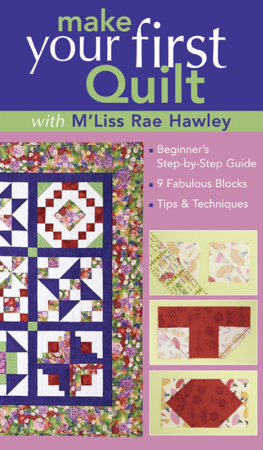

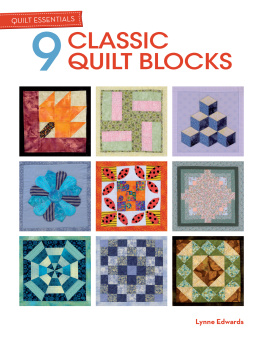
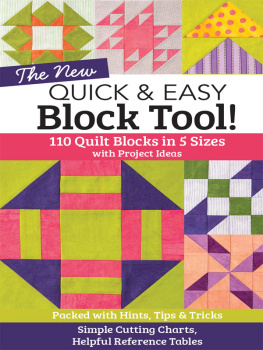

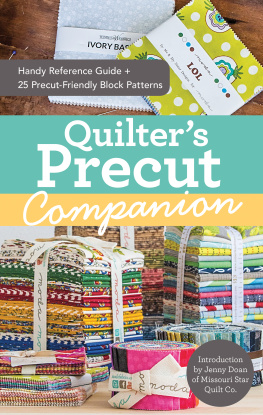
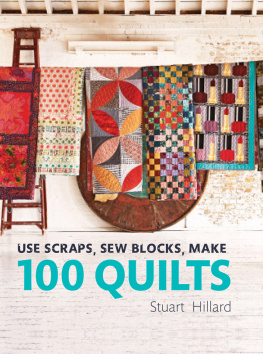
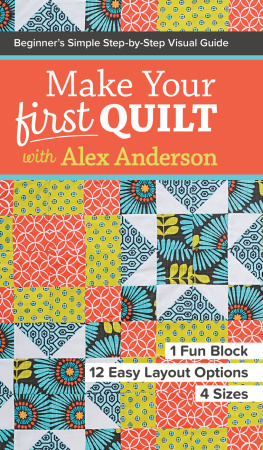
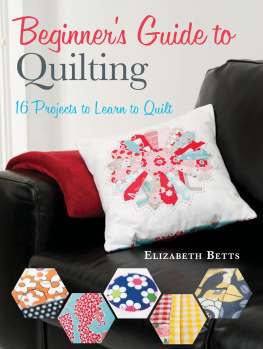


 Dedication This book is dedicated to YOU, the beginning quilter. You are about to experience the joy, creativity, and community of the world of quilting. You will be part of and contribute to its rich legacy and continuingtraditions. Enjoy!
Dedication This book is dedicated to YOU, the beginning quilter. You are about to experience the joy, creativity, and community of the world of quilting. You will be part of and contribute to its rich legacy and continuingtraditions. Enjoy! Acknowledgments I would most gratefully like to thank the following people and companies that share my vision, enthusiasm, and love of quilting, both personally and professionally, for their contribution to the industry. C&T Publishing: Amy Marson, Jan Grigsby, Darra Williamson, Gailen Runge, Kerry Graham, Tim Manibusan, and all the staff who continue to create wonderful books. Electric QuiltHusqvarna VikingJo-Ann Fabrics and Crafts StoreQuilters Dream BattingRobison-Anton TextilesSulky of AmericaPeggy Johnson, the Keeper of the Blocks, who helped draft the blocks in the book with The Electric Quilt Company software. Electric QuiltHusqvarna VikingJo-Ann Fabrics and Crafts StoreQuilters Dream BattingRobison-Anton TextilesSulky of AmericaPeggy Johnson, the Keeper of the Blocks, who helped draft the blocks in the book with The Electric Quilt Company software.
Acknowledgments I would most gratefully like to thank the following people and companies that share my vision, enthusiasm, and love of quilting, both personally and professionally, for their contribution to the industry. C&T Publishing: Amy Marson, Jan Grigsby, Darra Williamson, Gailen Runge, Kerry Graham, Tim Manibusan, and all the staff who continue to create wonderful books. Electric QuiltHusqvarna VikingJo-Ann Fabrics and Crafts StoreQuilters Dream BattingRobison-Anton TextilesSulky of AmericaPeggy Johnson, the Keeper of the Blocks, who helped draft the blocks in the book with The Electric Quilt Company software. Electric QuiltHusqvarna VikingJo-Ann Fabrics and Crafts StoreQuilters Dream BattingRobison-Anton TextilesSulky of AmericaPeggy Johnson, the Keeper of the Blocks, who helped draft the blocks in the book with The Electric Quilt Company software. Introduction You are about to set off on an exciting journey of color, fabric, design, and stitching that will bring a whole new dimension of creativity into your life. Welcome to the world of quilting! About 20 years ago, when I first started to teach quilting, I began with a Block-of-the-Month sampler quilt. (A visitor to my home will still see sampler blocks used as a border in our family room. It's constantly being updated and I also have a Christmas version.) For this sampler project I chose each block with care, so that each would build upon skills learned in the previous lessons, while also offering a new skill or technique to develop. I believed then, as I still believe these many years later, that the sampler quilt is a natural way to introduce a newcomer to quilting.
Introduction You are about to set off on an exciting journey of color, fabric, design, and stitching that will bring a whole new dimension of creativity into your life. Welcome to the world of quilting! About 20 years ago, when I first started to teach quilting, I began with a Block-of-the-Month sampler quilt. (A visitor to my home will still see sampler blocks used as a border in our family room. It's constantly being updated and I also have a Christmas version.) For this sampler project I chose each block with care, so that each would build upon skills learned in the previous lessons, while also offering a new skill or technique to develop. I believed then, as I still believe these many years later, that the sampler quilt is a natural way to introduce a newcomer to quilting.
 As with any first-time venture, it is important that you recognize and understand the key components of your new undertaking. It is also important that you assemble the best tools and materials for the job. Youll find lots of help in the next few pages!
As with any first-time venture, it is important that you recognize and understand the key components of your new undertaking. It is also important that you assemble the best tools and materials for the job. Youll find lots of help in the next few pages! Anatomy of a Quilt A quilt is basically a three-layer fabric sandwich. A sampler quilt the kind of quilt you will be making is composed of a series of different blocks.
Anatomy of a Quilt A quilt is basically a three-layer fabric sandwich. A sampler quilt the kind of quilt you will be making is composed of a series of different blocks.